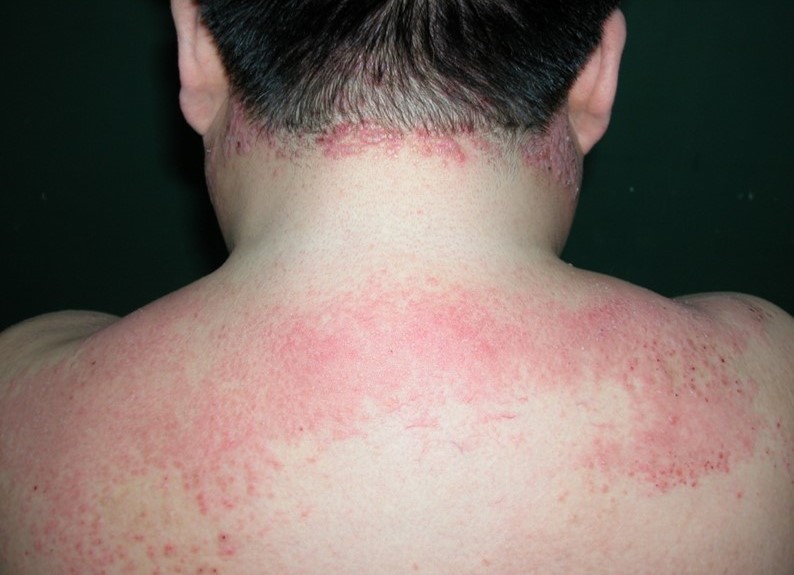Chronic Actinic Dermatitis in Thailand: A Study of Clinicophotobiological Characteristics and Treatment Outcomes Over 13 years
Keywords:
Chronic actinic dermatitis, Clinical, Photobiological, Phototesting, Photoprovocation testing, Photopatch testing, Patch testing, Outcomes of treatment, ThailandAbstract
Background: There have been reported chronic actinic dermatitis (CAD) cases in younger patients of darker skin types, particularly in South Asian. There remains a relative paucity of information of CAD patients in Southeast Asia generally and Thailand specifically.
Objective: Address clinicophotobiological characteristics of CAD patients and outcomes of treatments in Thailand.
Materials and Methods: Medical records of Thai patients who diagnosed CAD and confirmed by phototesting were reviewed retrospectively from a 13-year period at a single center. Clinicophotobiological features, and outcomes of treatments were evaluated.
Results: Of 90 patients, a preponderance of patients were male with a median age at diagnosis of 55.73 ± 12.01 years; 63.3% of the patients had Fitzpatrick skin type IV. All patients presented with eczema on photodistributed areas, only 11 of those patients (12.2%) presented with eczema on both sun-exposed and sun-covered areas. Most patients demonstrated photosensitivities to both UVB and UVA (67.8%). Only 3.5% of patients had a photoallergy to a fragrance mix and balsam of peru. Fifty percent of patients had allergic contact dermatitis with fragrance mix (14.4%), balsam of peru (6.7%), nickel (6.7%), p-phenylenediamine (5.6%), and cobalt (5.6%). Less than 50% of the patients required systemic immunosuppressive treatment. Most patients had a partial response within a median time of 4 months after treatment.
Conclusion: Thai patients with CAD who have higher skin types are predominately observed in males with an earlier age at onset. Most patients exhibit both UVA and UVB photosensitivities. The coexistence of CAD and allergic contact dermatitis is common.
References
Haxthausen H. Persistent hypersensitivity to light after intravenous injections of Trypaflavine. Br J Dermatol 1933;45:16–8.
Wang CX, Belsito DV. Chronic Actinic Dermatitis Revisited. Dermatitis 2020;31:68-74.
Menagé H, Hawk J. The idiopathic photodermatoses: chronic actinic dermatitis. In: Hawk JL, editor. Photodermatology. London: Arnold 1999;127-42.
Dawe RS, Ferguson J. Diagnosis and treatment of chronic actinic dermatitis. Dermatol Ther 2003;16:45-51.
Artz1 CE, Caitlin M, Farmer, CM, Lim HW, Chronic Actinic Dermatitis: a Review. Curr Dermatol Rep 2019;8:104-109.
Tan AW, Lim KS, Theng C, Chong WS. Chronic actinic dermatitis in Asian skin: a Singaporean experience. Photodermatol Photoimmunol Photomed 2011;27:172-5.
Russell SC, Dawe RS, Collins P, Man I, Ferguson J. The photosensitivity dermatitis and actinic reticuloid syndrome (chronic actinic dermatitis) occurring in seven young atopic dermatitis patients. Br J Dermatol 1998;138:496-501.
Quatrano NA, Shvartsbeyn M, Meehan SA, Soter NA, Cohen DE. Chronic actinic dermatitis occurring in an adult with atopic dermatitis. Dermatol Online J 2015;21:13030/qt1x19n7vm.
Wong SN, Khoo LS. Chronic actinic dermatitis as the presenting feature of HIV infection in three Chinese males. Clin Exp Dermatol 2003;28:265-8.
Elder D, Elenitsas R, Al E. Lever’s histopathology of the skin. Philadelphia: Lippincott Williams and Wilkins; 2015.
Paek SY, Lim HW. Chronic actinic dermatitis. Dermatol Clin 2014;32:355-61.
Chew AL, Bashir SJ, Hawk JL, Palmer R, White IR, McFadden JP. Contact and photocontact sensitization in chronic actinic dermatitis: a changing picture. Contact Derm 2010;62:42-6.
Patel N, Konda S, Lim HW. Dupilumab for the treatment of chronic actinic dermatitis. Photodermatol Photoimmunol Photomed 2020;36:398-400.
Majid I, Akhtar S. Tofacitinib in resistant chronic actinic dermatitis: A case series. Dermatol Ther 2022;35:e15467.
Maguire J, Gleeson D, Corso R, Pink A, Smith C, Ferguson J. Remission of chronic actinic dermatitis on baricitinib: A case report. Skin Health Dis 2023;3:e243.
Wolverton JE, Soter NA, Cohen DE. The natural history of chronic actinic dermatitis: an analysis at a single institution in the United States. Dermatitis 2014;25:27–31.
Dawe RS, Crombie IK, Ferguson J. The natural history of chronic actinic dermatitis. Arch Dermatol 2000;136:1215–20.
Sombatmaithai A, Silpa-archa N, Wongpraparut C. A cross-sectional with retrospective review of chronic actinic dermatitis: a rare photodermatosis in Thailand. J Med Assoc Thai 2018;101:119-25.
Bryden AM, Moseley H, Ibbotson SH, et al. Photopatch testing of 1155 patients: results of the U.K. multicentre photopatch study group. Br J Dermatol 2006;155:737-47.
Gu Q, Zhang Z, Yang J, et al. Chronic actinic dermatitis: A 5-year clinical analysis of 488 patients in China. Photodermatol Photoimmunol Photomed 2023;39:263-68.
Ellenbogen E, Wesselmann U, Hofmann SC, Lehmann P. Photosensitive atopic dermatitis - a neglected subset: clinical, laboratory, histological and photobiological workup. J Eur Acad Dermatol Venereol 2016;30:270-75.
Rutter KJ, Farrar MD, Marjanovic EJ, Rhodes LE. Clinicophotobiological Characterization of Photoaggravated Atopic Dermatitis. JAMA Dermatol 2022;158:1022-30.
Wong SN, Khoo LS. Analysis of photodermatoses seen in a predominantly Asian population at a photodermatology clinic in Singapore. Photoimmunol Photomed 2005;21:40-4.
Tan AW, Lim KS, Theng C, Chong WS. Chronic actinic dermatitis in Asian skin: a Singaporean experience. Photodermatol Photoimmunol Photomed. 2011;27:172-5.

Downloads
Published
How to Cite
Issue
Section
License
Copyright (c) 2025 Thai Journal of Dermatology

This work is licensed under a Creative Commons Attribution-NonCommercial-NoDerivatives 4.0 International License.
เนื้อหาและข้อมูลในบทความที่ลงตีพิมพ์ในวารสารโรคผิวหนัง ถือเป็นข้อคิดเห็นและความรับผิดชอบของผู้เขียนบทความโดยตรงซึ่งกองบรรณาธิการวารสาร ไม่จำเป็นต้องเห็นด้วย หรือร่วมรับผิดชอบใดๆ
บทความ ข้อมูล เนื้อหา รูปภาพ ฯลฯ ที่ได้รับการตีพิมพ์ในวารสารโรคผิวหนัง ถือเป็นลิขสิทธิ์ของวารสารฯ หากบุคคลหรือหน่วยงานใดต้องการนำทั้งหมดหรือส่วนหนึ่งส่วนใดไปเผยแพร่ต่อหรือเพื่อกระทำการใดๆ จะต้องได้รับอนุญาตเป็นลายลักอักษรจากบรรณาธิการวารสารโรคผิวหนังก่อนเท่านั้น


